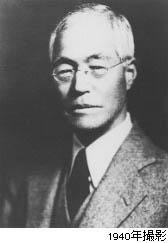Kan'ichi Asakawa | |
|---|---|
 | |
| Born | October 20, 1873 Nihonmatsu, Fukushima, Japan |
| Died | August 11, 1948 (aged 74) West Wardsboro, Vermont, United States[1] |
| Other names | 朝河 貫一, かん'いち あさかわ |
| Occupation | Japanese academic, author, historian, librarian |
Kan'ichi Asakawa (朝河 貫一, Asakawa Kan'ichi, December 20, 1873 – August 11, 1948)[2] was a Japanese academic, author, historian, librarian, curator and peace advocate. Asakawa was Japanese by birth and citizenship, but he lived the major portion of his life in the United States.
Early life
Asakawa was born in Nihonmatsu, Japan, and was educated at the Fukushima-ken Jinjo School in Fukushima Prefecture and at Waseda University in Tokyo before he traveled to the United States to study at Dartmouth College in Hanover, New Hampshire. He was awarded his BA degree in 1899.[3] He continued his studies at Yale University, earning his Ph.D. in 1902.[4]
Career
Asakawa lectured at Dartmouth College in 1902; was a professor at Waseda University (1906–07); an instructor at Yale University (1907–10); and became an assistant professor at Yale University in 1910. He carried on special research in Japan in 1906–07 and 1917–19. He became a professor at Yale University in 1937, becoming the first Japanese professor at a major American university. He was the author of many works on Japan, his scholarly interest being medieval history. He taught history at Yale for 35 years.[4] Among those he influenced was John Whitney Hall.[5]
In 1907, Asakawa was appointed curator of the East Asian Collection at Yale's Sterling Memorial Library.[4]
Asakawa helped found Asian studies in the United States.
Political perspective
After the end of the Russo-Japanese War, Asakawa began to speak out against the growth of militarism in Japan. He dedicated himself to serving as a bridge between the United States and Japan to promote amicable relations. In 1941, he sought to avert war between Japan and the United States by trying to convince President Roosevelt to reach out to the Japanese emperor with a personal telegram.[6]
Legacy
Every summer, Dartmouth students who are studying abroad in Japan take a trip to Asakawa's hometown of Nihonmatsu and pay homage by visiting both the high school where he studied, and his grave site.[7] Some of his remains are interred at Kanairo Cemetery in Nihonmatsu, and others are interred in the Grove Street Cemetery, New Haven, Connecticut.[2]
In 2007 the Asakawa garden in Saybrook College, designed by Shinichiro Abe, was dedicated to mark the centennial of Asakawa's appointment as an instructor of history at Yale.[8]
Selected works
- 1903 – The Early Institutional Life of Japan. Tokyo: Shueisha. OCLC 4427686; see online, multi-formatted, full-text book at openlibrary.org
- 1905 – The Russo-Japanese Conflict: Its Causes and Issues. Boston: Houghton-Mifflin. OCLC 2418247 [reprinted by Kennikat Press, Port Washington, New York, 1970.]
- 1914 – The Origin of Feudal Land-Tenure in Japan (1914)
Asakawa's works also included contributions to the publications Japan edited by Capt. F. Brinkley (1904); the History of Nations Series (1907); China and the Far East (1910); Japan and Japanese-American Relations (1912); and The Pacific Ocean in History (1917).
Notes
- ^ "Asakawa, Kanʾichi, 1873–1948 – Social Networks and Archival Context". snaccooperative.org. SNAC. Retrieved December 20, 2019.
- ^ a b "朝河 貫一(あさかわ かんいち)" (in Japanese). City of Nihonmatsu. Retrieved December 17, 2019.
- ^ Dartmouth College Catalogue, 1898–1899, p. 57.
- ^ a b c Yamato Ichihashi et al. (1999). Morning Glory, Evening Shadow: Yamato Ichihashi and His Internment Writings, 1942–1945, p. 69.
- ^ Mass, Jeffrey P. (1995). Antiquity and Anachronism in Japanese History, p. 15.
- ^ Cohen, Warren I. (1996). Pacific Passage: the Study of American-East Asian Relations on the Eve of the Twenty-first Century, p. 42.
- ^ "Nihonmatsu". Global Dartmouth. Dartmouth University. Retrieved December 17, 2019.
- ^ Reinstein, Gila (September 13, 2007). "Remembering a Japanese Scholar". YaleNews. Retrieved December 17, 2019.
References
- Cohen, Warren I. (1996). Pacific Passage: the Study of American-East Asian Relations on the Eve of the Twenty-first Century. New York: Columbia University Press. ISBN 978-0-231-10407-4
- Kiang, Lindsey. (1964). A Withdrawal to Greatness: The Life of Kanichi Asakawa. Hanover, New Hampshire: Dartmouth College, Senior thesis. OCLC 14190248
- Mass, Jeffrey P. (1995). Antiquity and Anachronism in Japanese History. Stanford: Stanford University Press. ISBN 978-0-8047-2592-7
- Tohru Takeda. (2007). "Kan'ichi Asakawa – Who Worked For World Peace." Sakyo Takaishi, JPS Inc. ISBN 978-4-88469-518-7
- Yamato Ichihashi and Gordon H. Chang. (1999). Morning Glory, Evening Shadow: Yamato Ichihashi and His Internment Writings, 1942–1945. Stanford: Stanford University Press. ISBN 978-0-8047-3653-4
External links
- Kanichi Asakawa – Japanese Historian
- Kan'ichi Asakawa at Find a Grave
- The Asakawa Centennial at Yale
- "Utsukushima Fukushima Story – The dreamer : Kan'ichi Asakawa"
- "The Treaty of Portsmouth by Kan'ichi Asakawa"
- "Asakawa Web-Museum by Asakawa Peace Association"
- Kan'ichi Asakawa Papers (MS 40). Manuscripts and Archives,Yale University Library.